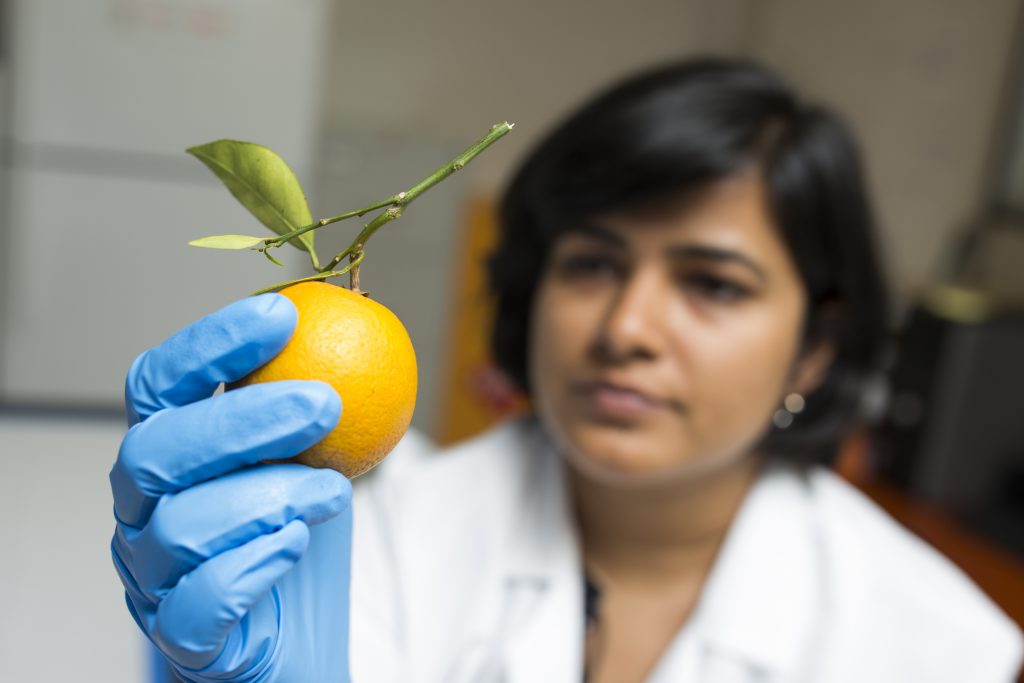
By: Brad Buck 813-757-2224 (office); 352-875-2641 (cell); bradbuck@ufl.edu
UF/IFAS citrus scientists Tripti Vashisth and Fernando Alferez are trying to reduce the amount of fruit that drops from Hamlin and Valencia trees prior to harvest. If fruit drops, growers can’t harvest it, and that leads to losses for farmers and less fruit at the market for consumers.
Normally, about 10% to 15% of citrus fruit drops from a healthy tree, said Alferez. With citrus greening now prevalent throughout Florida’s citrus growing regions, scientists and growers have seen pre-harvest fruit drop increase in the last decade, he said. In the 2012-2013 season, researchers and citrus farmers noticed about 25% of their crop lost because of greening-associated pre-harvest fruit drop. Now, depending on the citrus variety, growers may see a pre-harvest drop, and it could be up to 50%.
Fruit-Drop Issues
The two UF/IFAS scientists are studying many fruit-drop issues. For example, they’re looking into the effect of removing “fruitlets’’ – fruit that’s less than 2 centimeters in diameter – from so-called “off-blooms.”
“Typically, healthy citrus trees bloom early in spring, and they may have another wave of flowers later in the spring, but it is atypical for the tree to bloom in late summer,” said Alferez. Those would be an example of “off-bloom” fruit.
Preliminary experiments from the two UF/IFAS researchers show that removing “fruitlets” from off-blooms when Hamlin oranges are mature results in more mature fruit hanging onto citrus trees – as opposed to dropping — Alferez said. This may increase yield because the mature fruit drops less.
Valencia oranges are more complex, as several blooms occur during the last part of fruit maturation, he said.
“Also, we have found that fruit drop is associated with fruit development,” said Alferez, an assistant professor at the UF/IFAS Southwest Florida Research and Education Center in Immokalee, Florida. “Small fruit are more likely to drop.”
Another Finding
Another preliminary finding? Insufficient carbohydrates do not cause fruit drop. Therefore, the researchers recommend growers use good irrigation and nutrition practices during the fruit-development period. Vashisth and Alferez also say if growers apply gibberellic acid during the fruit-development period, it can help reduce fruit drop.
“Our preliminary findings are important because they show that the fruit drop related to HLB is not a simple process,” said Vashisth, an assistant professor at the UF/IFAS Citrus Research and Education Center in Lake Alfred, Florida. “There is no single cause for the fruit to drop. There have to be more causes, and that is what we are trying to understand now.”
In healthy trees, competition for resources between mature and “fruitlets” causes some ready-to-harvest fruit to drop.
Citrus Greening Disease
Citrus greening disease – known to scientist as huanglongbing (HLB) — may contribute to fruit dropping from trees. HLB has caused tremendous damage to citrus in Florida.
“In general, trees displaying fewer HLB symptoms or that are relatively healthy tend to have less pre-harvest fruit drop and can hold on to fruit for a longer time,” said Vashisth.
Usually, these “off-blooms” are not abundant; they’re only on a few branches, but it may affect tree performance if it is sick with HLB.
“In Hamlin and Valencia oranges, we have observed several off-blooms resulting in new fruit as the current crop is already developing,” Vashisth said. “This is normal in healthy trees growing in tropical or subtropical regions, such as Florida. However, in an HLB-affected tree, this may compromise the tree’s ability to keep fruit. It may also reduce yield, because the new fruitlets and mature citrus compete for carbohydrates.”
Funding for this research is possible by state legislative funding for the UF/IFAS Citrus Initiative and UF/IFAS new faculty funding.









